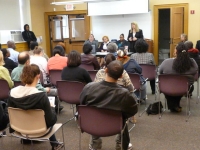Rethinking Springfield City Library
Springfield City Library, Mass.
Innovation Synopsis
The library undertook a community-wide effort to redesign the library system, to determine the number and hours for branch libraries and to reorganize staff into program and outreach teams to address key city issues: Adult Literacy & Lifelong Learning, Early Childhood, After School, Civic & Community Engagement and Workforce Development.
Challenge/Opportunity
The library was trying to operate 9 branch libraries with a budget that was already inadequate and was being reduced every year. This led to the hours at each branch being cut to 18 hours a week, with schedules that were confusing to the public. In the past, branches had been slated for closure, but citizen efforts always resulted in their being reopened. A model had to be found to regain equilibrium within budgetary constraints. It was also clear that, although library staff were working very hard, there were not enough hours in the day to get beyond keeping up with ongoing business. There was no time for outreach or for making headway on important city issues that the library felt it should be helping with. And there was no time to pursue partnerships with other community organizations and schools that could lead to positive results. The library's vision from its strategic plan was "A Brighter Future for Springfield Today," but there were not enough resources to deliver on that vision. It was also clear in meetings with community leaders that residents were not aware of some of the services the library provides. It was important to make the library a more "out there" service provider and player that the people and leaders of Springfield could understand and recognize as being valuable.
Key Elements of Innovation
Major Innovations:
- Recasting the library organization to transparently reflect community needs and priorities using meaningful language for city leaders and funders.
- Involving city leaders from the start to appreciate the issues and to offer different approaches that will result in outcomes that will improve library services and recognize budget constraints.
- Engaging library program managers and staff to connect the ‘what we learned from city leaders’ to the front lines of library services in the city and its neighborhoods.
Process:
- Meet with sponsors to refine the project and secure funding.
- Review, analyze and present comparative data on communities and libraries.
- Study library service patterns.
- Discuss citywide needs, goals and initiatives with community leaders and library staff.
- Discuss preliminary findings and recommended scenarios with project sponsors and city leaders.
- Submit a FY14 budget to the City incorporating new directions.
- Convene community meetings to present the project and the selected scenario.
Achieved Outcomes
The outcomes have been greater than anyone had ever envisioned. A key was that the Mayor became invested in the library’s role in improving the lives of community residents. He recommended, and the City Council approved, a budget increase of 15%. One branch ceased operation as a library and was repurposed as a senior center, and another became a new “Express Library.” These actions and the budget increase enabled the library to hire more staff and to increase hours at the remaining branch libraries from 18 to 30 per week. Residents no longer had to keep track of which branches were open which hours on which days. All were open every afternoon and one morning and one evening a week, and each was open on Saturdays. These more predictable and reliable schedules have led to huge increases in use by the public. In the 5 months between November 2013 and March 2014, examples of service increases at those branches included 20% more circulation, 37% more use of library computers, wi-fi up 52%, 52% more children attending programs, teen program attendance up 115%, 29% more visitors and 53% more people attending community meetings in library meeting spaces. In addition to expanded branch hours, a great deal of the increased use is due to the activities of the program and outreach teams. They have been drawing a wide variety of people to the libraries with innovative programs that are clearly meeting the needs of residents.

